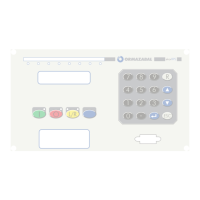IG-150-EN version 04; 03/10/16
54
Protection functions. Description and settings General instructions
ekor.rps
4. Protection functions. Description and settings
4.1. Phase overcurrent protection
4.1.1. General description
Three-phase overcurrent protection, with the next selectable
characteristics (function 5051):
Timed characteristic
1. Inverse normal time( I BSC
[3]
or I ANSI))
2. Inverse short time(IC BSC)
3. Inverse long time (IL BSC)
4. Very inverse time (MI BSC or MI ANSI)
5. Extremely inverse time (EI BSC or EI ANSI)
6. Very inverse special time (MIEs BSC)
7. Moderately inverse time (ANSI)
8. User curve(USER 1 or USER 2)
9. Denite time
10. Drop out with disc emulation option
Instantaneous characteristic
1. Two instantaneous elements
2. Additional time
The operation of this protection is coordinated with the
reclosing function.
Some protection families have a second directional
overcurrent function (67, 67N), called HIGH2, which is
independent from the rst one.
4.1.2. Settings ranges of the timed characteristic (6 tables) (normal and HIGH2)
Setting Min Max Step Notes
Enable
YES/NO/pickup/YES+drop out
Pickup [A]
0.02 40.00 0.01 With standard ratings
0.1 200.0 0.01 With specied ratings
Curve type
Denite time
Normal curve, very inverse, extrem. inverse, etc.
User curve
Time index
0.05
0.5
1.09
30.0
0.01
0.1
For IEC curves
For ANSI curves
Denite time [s]
0.0 600.0 0.01
These settings can be found in the console on the screen “overcurrent protection (1)”. PHASES TIME SETTING box.
Table 4.1. Settings ranges of the timed characteristic
They can be modied depending on the voltage, if the unit
contains the option 51 V (see “voltage control”).
If the enable setting is set at YES, the function can generate
trips, if it is at NO it is not carried out. If it is at PICK UP, it picks
up but it doesn’t give tripping signal. If it is at YES+DROP, This
happens by emuling the disc (see below). This is general for
overcurrent functions.
[3]
Equivalent to IEC 255-4
The pick up current is set in amperes in the secondary.
Working in denite time, the relay trips after the set time,
since the starting current has been exceeded, is elapsed,
independently from the current value.

